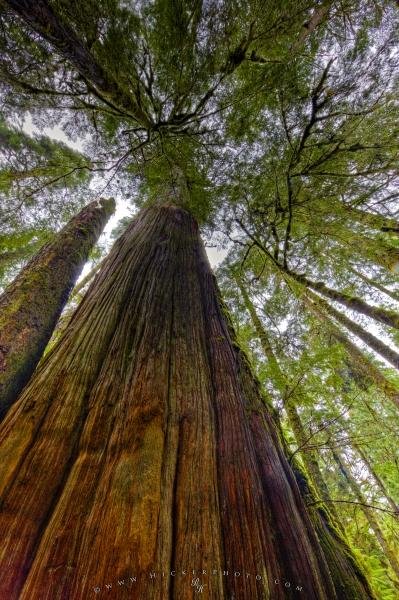Photo: Western Red Cedar Forest Canopy Picture
The Western Red Cedar, a majestic old man among the forest of the Pacific Rim National Park, Clayoquot Sound UNESCO Biosphere Reserve. The Western Red Cedar is part of the cypress family and dominates the forest canopy.
The Western Red Cedar, Thuja plicata, is not of the cedar family but the cypress family. Plicata, is the cedar's species name, it means "folded in plaits" because of the small leave pattern. Another name is the Giant Aborvitae. Other names it is known by is the Pacific red cedar, British Columbia cedar, canoe cedar, giant cedar, and red cedar.
The Western Red Cedar is the Provincial tree of British Columbia and is a tree which Native Americans of the west coast refer to as the "long life maker".
These western red cedars generally have a very long life. These trees have been known to live for nearly a thousand years old, maybe even older. The forests of The Queen Charlotte Islands in British Columbia, have some specimens that are approximately nine hundred years old.
They are very large trees. Their height can vary from 12 to 45 meters tall (40 to 150 feet) and the trunk can be as large as 7 meters (22 feet) which can make for a dense forest ... continue below the picture...
Western Red Cedar Forest Canopy Picture

canopy at a majestic Western Red Cedar tree.
Pictures from photo gallery "Pictures Of Hoover Dam Nevada"
This picture is part of the photo album "Tree Pictures" - there are more beautiful images waiting for you.
Related stock photo galleries, pictures & travel ideas:
Western Red Cedar Forest Canopy Picture
... canopy.
According to carbon-dating and pollen analysis the cedar tree has been around for about 6,600 years. The first tree grew around the lower Fraser Valley.
Western red cedar tree (western red cedar), Thuja plicata, along the Rain forest Trail in the coastal rain forest of Pacific Rim National Park, Long Beach Unit, Clayoquot Sound UNESCO Biosphere Reserve, West Coast, Vancouver Island, British Columbia, Canada.
Technical Information:
I photographed this photo with the digital SLR camera model Canon EOS-1Ds Mark III, aperture of f/13.0, exposure time of sec. on ISO 100, as always I used a original Canon Lens, the focus lenght for this picture was 14mm.
The Western Red Cedar, a majestic old man among the forest of the Pacific Rim National Park, Clayoquot Sound UNESCO Biosphere Reserve. The Western Red Cedar is part of the cypress family and dominates the forest canopy.
